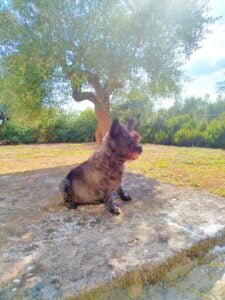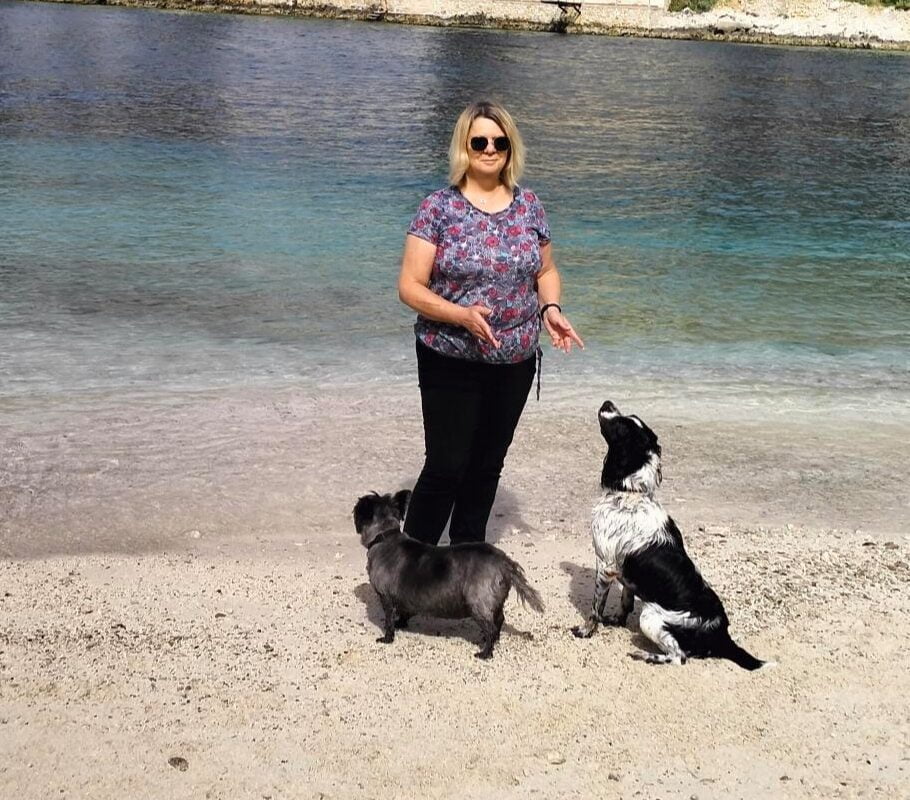Last Updated on 20/06/2024 by Claire Coney
You plan to travel with your dog but don’t want to spend time worrying about him while away. It’s one of the biggest dilemmas a pet owner faces. To ensure your furry friend’s comfort and safety for travel involves some important steps. Have you considered that your dog might need extra training? If you train your dog before you travel you can both have a great experience together.
Like many other canine owners, I took my dogs to puppy training classes when they were young. Then they progressed through the intermediate classes to advanced level training. Of course, bad habits creep in over time, so I revisit their training regularly. I also ensure that their training is adapted to our travel needs.
The Fido trail is supported by its audience. When you purchase through links on our site, we may earn an affiliate commission.
Train Your Dog To Travel in a Crate
If you are planning to travel with your fur buddy, crate training is vital.
I introduced Abigail to the crate when I first got her at 2 years old. Whereas, I introduced Charlie to the crate as a puppy. Consequently, it took longer to crate-train Abigail than it did with Charlie. To begin with, they both slept in their crates every night. This ensured they never had accidents at night. Instead, they learnt to bark by the back door if they needed to potty outside. As Abigail and Charlie got older, they switched to dog beds.
My dogs transferred their skills to the car with ease. They started with short journeys to fun places like the beach or woods for an exciting walk. The length of the journey was increased to holiday destinations in the UK. Now, they are experienced travellers enjoying road trips through Europe. As a result, Abigail and Charlie love going into their crates when they are going on a journey.
Even if you haven’t crate-trained your pup from an early age, it is possible to start in later life. I have provided some information about travelling with a dog by car here.

Waiting at Doorways
If you want to travel with your dog train them to wait at doorways. This is an important safety behaviour to help prevent accidents in various situations. The “wait” command is useful for stopping your dog from hazards, like busy roads. It will also help in unfamiliar places where they might become lost or stressed. This command is particularly, valuable for high-energy dogs such as Charlie.
I began training Charlie to wait at the back door at home. This door enters our enclosed garden making it a safe place to start training him. There were few distractions, and he could focus on me. Gradually I took him to parks and towns which increased his level of distraction. This helped Charlie to transfer his skills to all doorways, gateways and thresholds.
When Charlie waited successfully, I used tasty training treats and praise as a reward. Thus, He enjoyed his training. As a result, Charlie quickly learns to obey the command. It took patience and consistency, but it was worth the effort to keep Charlie safe.

Potty Cues
Train potty cues with your dog before travel is a practical strategy. Particularly for pet owners who often travel. This technique helps maintain your dog’s routine during travel. It also ensures cleanliness and convenience during trips. It proves useful at rest stops on long drives and before boarding a flight or ferry. It’s also handy before settling into a hotel room in a skyscraper. The challenge lies in encouraging your dog to potty in unfamiliar places or on different surfaces. Many dogs, like Charlie, prefer grass. Initially, I had to locate grassy areas for him to relieve himself. However, as Charlie became accustomed to travelling, he adapted to new toileting spots. Abigail, on the other hand, will potty anywhere.
Remember, the goal is to make your dog comfortable with the routine. Always provide ample opportunities for them to understand and adapt to the cue.

Train Your Dog to Recall Before Travel
If you want to allow your dog off the lead when travelling, they must be trained to return when called. Foreign places usually have more distractions than those at home. If your dog runs off, they won’t know where home is. When travelling or in strange places recall is a vital skill.
I practice recall with my dogs in a variety of settings. I started training recall at home in familiar surroundings. Then, I gradually increased the level of distractions on walks in the park while other dogs were around. Also, on the beach where there are many scents and sights. Charlie’s recall is reliable, and he loves to come when called. Abigail, however, is more independent. If she finds something interesting, she’s slower to return. Thus, sometimes it’s better to keep her on the lead where she is safe.
Additionally, many places and tourist attractions will have rules requiring dogs to be on leads.

Leave It
Train your dog to respond to the “leave it” command before you travel. I find this particularly useful with Abigail. She is a foodie and would snack while out and about if given the opportunity. Using the words “leave it” keeps her from eating items that could be hazardous to her.
I taught Abigail to focus on me and await instructions, rather than acting on impulse. It started with simple exercises, like ignoring treats in my closed hand. Gradually she progressed to more challenging scenarios, like leaving food or objects she found on the ground. Over time, Abigail learnt to look for my guidance when she was unsure about something. This helps make travel and outings much safer and more enjoyable for us.
This Way
Training Charlie to understand the commands “this way” ensures his safety during walks. This command is a cue that prepares him to pay attention and awaits further instructions. I can tell him to navigate through new environments or to avoid potential hazards. Using commands like left, right, and come back are useful in situations involving unfriendly dogs or other dangers. This approach keeps Charlie safe and strengthens our bond. It builds on trust and clear communication. It’s a testament to the remarkable ability of dogs to learn and adapt to various commands.

Limit Nuisance Barking
It is not ideal to have a dog that barks a lot when you are travelling. However, you can train your dog to bark less when you travel. This helps foster a harmonious environment for both the dog and the community.
When Abigail and Charlie remain quiet, in situations where they would typically bark, I reward them with treats or affection. Conversely, when they bark, I redirect them to a different activity. I also use a word to help them learn to control their impulses.
You could also try a training clicker to distract your dog when it barks. The sound helps bring its attention back to you. Gradually lengthen the time before you give them a treat.
It’s important to understand what triggers a dog to bark, as it may signal their desires or feelings. It’s not necessary to eliminate barking altogether. With patience and understanding, you can teach your dogs to express themselves in better ways.
I also consider environments that are likely to make my dogs bark and avoid it. For instance, Abigail is likely to bark in a noisy room. If she hears a lot of noise outside, it upsets her, and she will bark. I tend to look for rental accommodation in quiet areas where external noise is less likely to disturb her.
Some dogs bark when their owners are sitting in a cafe or restaurant. They might get bored. Or they don’t understand why they are not getting attention from their owners. You can give your dog a chewy treat and a kong toy to keep them occupied and happy.
Socialization and Desensitization
In preparation for travel with your dog, acclimate them to different environments and stimuli. This ensures their comfort and reduces anxiety during travel.
I gradually introduced Abigail and Charlie to different sights and sounds. I took them to experience crowded areas and unfamiliar accommodations. This helped them to become more adaptable and less stressed when faced with new situations.
Train Your Dog to Meet People Politely For Travel
If you are travelling with your dog, they should greet people politely, particularly if your dog is large or lively. This can be challenging if you have a high-energy dog like Charlie who loves to say hello to everyone.
I began by training Charlie basic commands like ‘sit’ and ‘stay’ at home where there was less distraction. Then Charlie progressed outdoors amidst distractions until his behaviour was reliable.
It’s crucial to remain calm during greetings. Dogs often mirror their owners’ energy. I rewarded Charlie’s calm behaviour with treats. I also discouraged his excitement and ignored his jumping. Instead, I asked him to sit. I introduced Charlie to new people in controlled settings. At first, he was a little nervous about strangers, but I addressed this fear gently and gradually. He began by observing strangers from a distance where he felt safe. I didn’t force him to interact with people. I monitored his body language for stress and never punished him for being scared. This can exacerbate the problem. Charlie now associates strangers with positive experiences.

Muzzle Train Your Dog For European Travel
Muzzle training is an important aspect of travelling with a dog in Europe. Some countries have regulations requiring dogs to wear muzzles on public transport. It’s essential to familiarize your dog with a muzzle before your trip to ensure they are comfortable.
I started introducing the muzzle to my dogs in a positive way, with treats. Gradually I increased the time that Abigail and Charlie wore their muzzles. This ensured they were comfortable and relaxed.

Consistency and Patience
Training dogs before travel is an exercise in patience and consistency. Each dog has its own personality and learning speed, so it’s important to tailor the training to the individual dog. For instance, Abigail is clever and learns quickly but is independent. She loves to find her own adventures. Charlie, on the other hand, is like Velcro and is always waiting for a job.
Consistent commands help my two dogs understand what is expected of them. While patience allows them to learn at their own pace. Positive reinforcement, such as treats or praise, encourages good behaviour. It also strengthens my bond with them both.
Remember, successful training is not just about obedience. It’s about fostering a trusting and loving relationship with your furry friend.
Wrapping It Up
You have learnt a lot about how to train your dog before you travel. Here are some main points to remember:
- Crate training your dog is crucial before you travel with your furry friend. It keeps your dog comfortable, safe and secure. This will help you and your dog to relax and enjoy your journey together.
- Training your dog to wait at doorways and thresholds is valuable for them to learn. It might prevent your furry friend from having an accident and keep them secure on your travels.
- Potty cues are a practical approach when you are out and about on your foreign travels.
- Recall is a great tool when your dog is in unfamiliar surroundings and a foreign country.
- Training your dog to leave it can prevent your dog from eating harmful items when travelling.
- Teaching your dog a command like “this way” can get your dog’s attention quickly. Then you can redirect them away from potential danger.
- Train your dog to bark less so they don’t become a nuisance in holiday accommodations, restaurants or cafes.
- Acclimating your dog to foreign places ensures their comfort and reduces anxiety during travel.
- It is important to train your dog to meet and greet people politely so they can have a positive experience on your trip.
- It’s essential to familiarize your dog with a muzzle before your trip to Europe. This will ensure they are comfortable and comply with country or transport regulations.
- Training dogs requires patience and consistency. Each dog’s personality and learning speed are different. It’s important to tailor the training to the individual dog’s needs.
With these tips, you can train your dog before travelling and have a great time together on your next adventure.

Now I am curious:
Did you enjoy training your dog before travelling? Where did you and your dog go on your trip away from home?
Share your experience in the comments below.
(And if you want more tips on how to crate train your dog before travelling check out this article.)
crate train your dog before travelling





